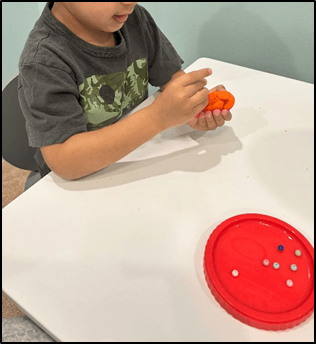Description
Children will learn about bannock, a traditional fry bread made by many Indigenous cultures around the world. They will listen to a rhyming story and make their own play bannock dough.
Number of participants
For one or more participants
Space considerations
An indoor space with tables and chairs for participants and their caregivers to listen to the facilitator and to do a craft. Participants may want to sit in a circle or group for the story and then move to tables.
Competencies
- Building language skills through rhyme
- Tactile and fine motor skills
- Pattern-making
- Categorization and decision-making
Materials
- Printout of rhyme from Bannock in a Hammock or a copy of the book
- Palm-sized ball of playdough for each child
- Cutting and rolling tools for the dough (e.g., pieces of cardboard, popsicle sticks, small cans)
- Small mix-in items in a variety of colours and textures: small beads, pebbles, bits of sticks/twigs, small pompoms, cut-up paper straws, etc.
Preparation
- Set out a small display of books related to bread and breadmaking.
- Prepare the room with your supplies, or keep them in a separate space ready to be distributed.
Implementation
- Distribute copies of rhyme for parents/caregivers and participants to follow along.
- Introduce yourself and talk a little about what bannock is: a type of fry bread made of a few simple ingredients that is made all around the world, especially by various Indigenous groups.
- Read aloud the selected rhymes from the book Bannock in a Hammock (from provided sheet) and have participants follow along with actions to make the activity more interactive. Note that there is a section where a child’s name can be swapped out for a name of a child in your program! To extend the program, you can always read the entire book.
- After sharing the rhymes from Bannock in a Hammock, ask if anyone has any type of bread that they eat that might be unique or special in their culture, e.g., naan, pita, injera, challah, ciabatta, tortilla.
- Discuss how bread is made and shared all over the world:
- How do they make it?
- What are some things you might eat it with? (for example, bannock can get dipped in honey)
- Do you bake it in a special way? Fry it?

- Distribute the playdough and set out the mix-in items. Encourage participants to use the dough tools and their hands to experiment with different shapes, sizes and thicknesses for their play bannock.
- Have participants share their playdough bannock if they wish to. Did they create patterns with how they mixed in their small items? Or did they randomly add mix-ins? Ask what their bannock might taste like (without actually eating it!) Is it savoury? Sweet? A little spicy? Ask what kind of flavours they might like to try, or what they might eat with their bannock.
Accessibility considerations
- Use various tactile elements as “mix-ins” for the play bannock, with attention to items of different textures, shape and size.
- To limit overstimulation, offer only two or three options, separated into shallow containers for easy access.
- If resources allow, consider using real ingredients and prepping edible bannock, following the recipe at the back of Bannock in a Hammock or from Métis Like Me. This may be an option for older participants as well.
- Consider writing the read-aloud portion of the activity on a whiteboard in larger text, printing large-print handouts, and using a microphone when speaking or reading aloud.
- Have participants pick up each of the “mix-in” items and name them to allow connection between language and touch.
Book suggestions
- Bannock in a Hammock by Masiana Kelly and Amiel Sandland
- Métis Like Me by Tasha Hilderman and Risa Hugo
- The Only Way to Make Bread by Cristina Quintero and Sarah Gonzales
- Hot Cross Buns for Everyone! by Yolanda T. Marshall and Daria Lavrova
- Baking with Mi Abuelita by Julissa Mora